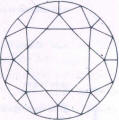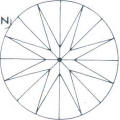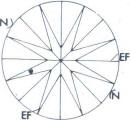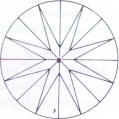Clarity grading not only serves to evaluate quality of a cut diamond, but especially in the case of larger stones, serves to establish its identity.
Certificates and expertises are therefore issued which include measurements, weight, color, clarity and cut, remarks as to any characterizing marks of the stone, so it can be identified at any time, In practice, there are no two diamonds alike in all details, so that a careful and exact "portrait" of all identity marks is in most cases possible.
To make the description easier, the internal and external features are drawn into an identity diagram, which shows the appearance of the inclusions at 10 x magnification exactly as to shape and in proportion. Size, number and position of any internal and external features must agree in all details in the drawing and the original stone, One should be able to read off the relevant clarity grade from an identity diagram.
Faults in the symmetry are not entered in the diagram, To differentiate between internal and external. features, inclusions are drawn in red ink, while external markings are shown in green ink. A very fine pen is used.
To represent inclusions and external defects internationally acceptable symbols and signs are used which represent the type and nature of the feature, so that an expert viewing it knows at once whether there are cracks, crystal inclusions, clouds, structural disorders, whether there are natural crystal faces, twinning lines or growth planes (Fig, 174).
| Fig 174 Symbols of representation of the internal features | |||
|
|
pinpoint |
|
large dark or colored inclusion |
|
|
group of pinpoint |
|
dark or colored inclusion surrounded by a cloud |
|
|
dark spot |
|
small cleavage or crack |
|
|
group of dark spots |
|
larger cleavage or crack |
|
|
cloud of tiny light pinpoints |
|
girdle fringes |
|
|
colorless crystal |
|
girdle cleavage surrounded by a cloud |
|
|
group of colorless crystals |
|
growth or twin line, colorless |
|
|
cleavages around colorless crystal |
|
growth of colored or black twin line |
The features are marked systematically on the diagram. The diagram of the crown shows all features and defects which are visible from the crown, and are situated on or below the table or any crown facet. An exception is made for those faults which are visible from above, but are situated on the surface of a pavilion facet or-those which extend from the surface of a pavilion facet into the stone. Only features which are only discernable from the pavilion are marked into the pavilion diagram. These are mainly small defects, often cracks situated just under the girdle.
Generally inclusions are only marked once, unless they extend from the crown facets over the girdle into the pavilion. This sometimes happens with larger cracks, which are then drawn into both diagrams.
Reflections of inclusions are only drawn into the diagram If they are decisive for the appearance and grade of clarity.
A few examples are given of the marking of features in order to explain the method and help towards a clearer understanding of it.
1st example
observation: A brilliant shows a crack at "one o'clock" below the crown facets. The crack is actually on the pavilion facets, which can easily be seen when the stone is rotated 1800 around its horizontal axis.
Diagram: The crack is marked at "five o'clock" in the pavilion diagram (Fig 175).
 |
 |
| Fig 175 | |
2nd example
Observation: A crystal inclusion under the table of a brilliant is reflected several times in the pavilion facets. The girdle is flattened at "seven o'clock" and it was assumed that at that point on the pavilion there was a natural crystal face or, an extra facet, an assumption that was confirmed when the stone was rotated.
Diagram: The crystal inclusion is marked under the table of the crown diagram; the reflections are not marked. The natural crystal face which was found on the pavilion at "eleven o'clock" is marked in the pavilion diagram (Fig 176).
 |
 |
| Fig 176 | |
3rd example
observation: A brilliant shows several natural crystal faces and extra facets on its pavilion. When viewed through the crown a definite blow indentation is discernable on a pavilion facet edge.
Diagram: The natural crystal faces and the extra facets are marked on the pavilion diagram on the same facets in relative size as they are found in the stone. The blow indentation, which was visible through the crown, is also drawn on the pavilion diagram (Fig 177).
 |
 |
| Fig 177 | |
It should be possible in every case to deduce clarity grade and type of inclusions as well as external defects from the identity diagram.
Thus the following representations can be interpreted:
1st example (Fig 178)
Two small scratches on the table. Two small naturals underneath the girdle, fringed girdle in places.
| Clarity grade: loupe clean | Quality of cut: good |
 |
 |
2nd example (Fig 179)
Two dot-like inclusions under the crown main facet. One natural into the girdle. A scratch on the pavilion main facet, slightly damaged culet.
| Clarity grade: VVS 2 | Quality of cut: good |
 |
 |
3rd example (Fig 180)
Small colorless inclusion under the table, small cleavage crack under a crown main facet, small fracture crack under the girdle on a pavilion girdle facet edge. A small extra facet on pavilion.
 |
 |
| Clarity grade: VS 1 | Quality of cut: very good |
| Representation of internal and external features in the identity diagram | Microphotography |